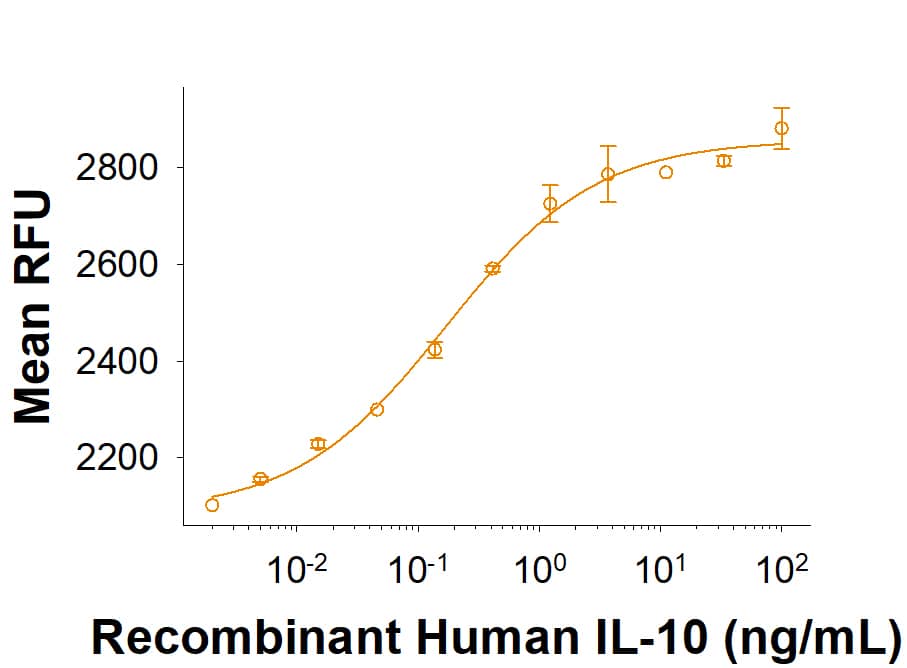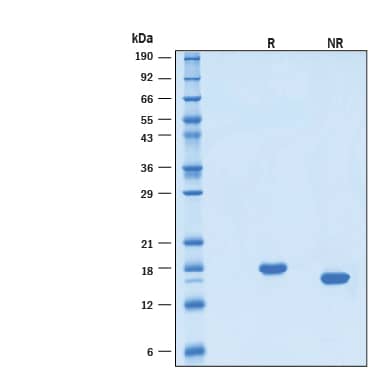Recombinant Human IL-10 Protein, CF Best Seller
R&D Systems, part of Bio-Techne | Catalog # 1064-ILB
Analyzed by SEC-MALS.

Key Product Details
Source
E. coli
Accession #
Structure / Form
Noncovalently-linked homodimer
Conjugate
Unconjugated
Applications
Bioactivity
Product Specifications
Source
E. coli-derived human IL-10 protein
Ser19-Asn178, with a N-terminal Met
Ser19-Asn178, with a N-terminal Met
Purity
>97%, by SDS-PAGE visualized with Silver Staining and quantitative densitometry by Coomassie® Blue Staining.
Endotoxin Level
<0.10 EU per 1 μg of the protein by the LAL method.
N-terminal Sequence Analysis
Met
Predicted Molecular Mass
19 kDa
SDS-PAGE
18 kDa, under reducing conditions.
Activity
Measured in a cell proliferation assay using MC/9‑2 mouse mast cells. Thompson-Snipes, L. et
al. (1991) J. Exp. Med. 173:507. The ED50 for this effect is 0.075-0.750 ng/mL.
Scientific Data Images for Recombinant Human IL-10 Protein, CF
Recombinant Human IL‑10 Protein SEC-MALS.
Recombinant human IL-10 (Catalog # 1064-ILB) has a molecular weight (MW) of 36.7 kDa as analyzed by SEC-MALS, suggesting that this protein is a homodimer. MW may differ from predicted MW due to post-translational modifications (PTMs) present (i.e. Glycosylation).Recombinant Human IL‑10 Protein Bioactivity.
Measured in a cell proliferation assay using MC/9‑2 mouse mast cells. The ED50 for this effect is 0.075-0.750 ng/mL.Recombinant Human IL‑10 Protein SDS-PAGE.
2 μg/lane of Recombinant Human IL‑10 Protein (Catalog # 1064-ILB) was resolved with SDS-PAGE under reducing (R) and non-reducing (NR) conditions and visualized by Coomassie® Blue staining, showing bands at 18.4 kDa.Formulation, Preparation and Storage
1064-ILB
| Formulation | Lyophilized from a 0.2 μm filtered solution in PBS with Trehalose. |
| Reconstitution | Reconstitute at 100-500 μg/mL in PBS. |
| Shipping | The product is shipped at ambient temperature. Upon receipt, store it immediately at the temperature recommended below. |
| Stability & Storage | Use a manual defrost freezer and avoid repeated freeze-thaw cycles.
|
Background: IL-10
References
- Pestka, S. et al. (2004) Annu. Rev. Immunol. 22:929.
- Sabat, R. et al. (2010) Cytokine Growth Factor Rev. 21:331.
- Mathurin, P. et al. (2002) Am. J. Physiol. Gastrointest. Liver Physiol. 282:G981.
- Grewe, M. et al. (1995) J. Invest. Dermatol. 104:3.
- Szony, B.J. et al. (1999) Mol. Hum. Reprod. 5:1059.
- Vieira, P. et al. (1991) Proc. Natl. Acad. Sci. 88:1172.
- Hsu, D.-H. et al. (1990) Science 250:830.
- Windsor, W.T. et al. (1993) Biochemistry 32:8807.
- Syto, R. et al. (1998) Biochemistry 37:16943.
- Kotenko, S.V. et al. (1997) EMBO J. 16:5894.
- Kotenko, S.V. et al. (2000) J. Biol. Chem. 276:2725.
- Hor, S. et al. (2004) J. Biol. Chem. 279:33343.
- Sheppard, P. et al. (2003) Nat. Immunol. 4:63.
- Fitzgerald, D.C. et al. (2007) Nat. Immunol. 8:1372.
- Wu, K. et al. (2007) Cell. Mol. Immunol. 4:269.
- Blackburn, S.D. and E.J. Wherry (2007)Trends Microbiol. 15:143.
Long Name
Interleukin 10
Alternate Names
CSIF, GVHDS, IL10, IL10A, TGIF
Entrez Gene IDs
Gene Symbol
IL10
UniProt
Additional IL-10 Products
Product Documents for Recombinant Human IL-10 Protein, CF
Product Specific Notices for Recombinant Human IL-10 Protein, CF
For research use only
